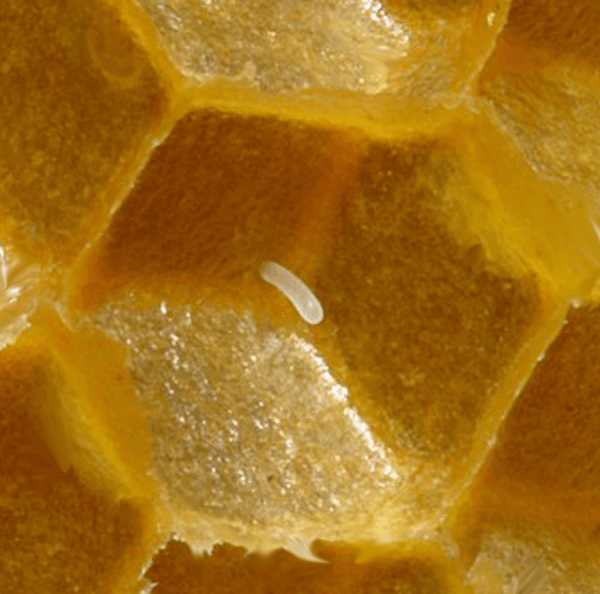Can Worker Bees Lay Eggs?
The queen in the honey bee colony is the chief egg-layer, whilst workers forage and perform nest duties (including helping to rear the offspring). Drones ensure future generations of honey bee colonies by mating with the queens.
But given that the workers are females, you may be wondering whether worker bees can lay eggs.
The short answer is:
Worker bees are able to lay eggs.
Since the workers do not get to mate, all of these eggs will be unfertilized and would produce drones only - i.e. they are male haploid eggs.
Egg Laying In Worker Bees
Here, we'll look at
- reasons for egg laying workers in honey bee colonies,
- differences in worker-laid eggs vs queen laid eggs,
- identification of these eggs in the cells, and
- beekeeper responses.
1. Why worker egg laying occurs in honey bee colonies
Usually, colony behavior, egg laying and ovary development in worker honey bees is prevented by queen pheromones and open brood pheromone.
However, in the absence of these regulating pheromones, workers may develop ovaries which will enable them to lay their own eggs.
Egg laying may occur due to:
- Complete loss of the queen, and failure to replace her.
This could occur for example, during a mating flight, perhaps due to predation, bad weather or accident.
If a beekeeper fails to notice the absence of the queen, the colony will be queenless.
Such a scenario will induce egg laying in workers. - A weaker or 'failing' queen that has not been superseded.
This may cause inadequate secretion of pheromone, thus resulting in egg laying by workers.
It is estimated that in queenright colonies of mixed European origin, only approximately 7% of all male eggs originate from laying workers1.
However, only one adult male in 1000 is a worker's son2.
2. How are worker eggs different from queen laid eggs?
- Eggs laid by workers are unfertilized, male haploid eggs. However, there are some exceptions in some subspecies of honey bee.
For example, workers of the Cape honey bee, Apis mellifera capensis, are able to produce diploid female eggs3 (also, see Do bees have X and Y chromosomes?). - However, scientists have detected no difference regarding nutrient content4 between queen and worker-laid eggs.
- Worker laid eggs are more susceptible to dehydration than those laid by queens4.
- Worker-laid eggs have been found to develop more slowly than queen-laid
eggs in the majority of instances, and it is hypothesized that they may only be partly mature at the moment they are
laid4.
3. How can beekeepers identify worker-laid eggs
Beekeepers can identify eggs laid by worker honey bees by looking out for the following 3 signs:
 An egg laid by a honey bee queen.
An egg laid by a honey bee queen.- Off-centre egg in the cell
Queens have longer abdomens, enabling them to reach right into the egg cell with her ovipositor. Queens are therefore able to deposit each egg in the centre of a cell.
In contrast, worker honey bees are smaller than queens with shorter abdomens. This means they cannot reach the bottom centre of the cell, and the egg ends up being positioned at the side or somewhat off-centre. - Multiple eggs in a cell
Queens will only lay one egg per cell, worker honey bees may sometimes lay more than one egg in a cell. - 'Humped brood'.
Workers lay eggs in cells intended for workers rather than the larger drones.
However, workers can only male haploid eggs. The larvae developing from these eggs will 'stick out' as it develops in the cell, causing the honey bee workers to build wax around the cell to cover the larvae properly.
Emerging drones are smaller than drones reared from drone cells.
4. What actions can beekeepers take?
Egg laying workers is thus a sign of a major problem beekeepers need to remedy. However, workers will usually reject any attempt to introduce a new queen by killing it.
Here are two potential methods to deal with this problem:
- In order for the new queen to be accepted, the ovaries of the egg laying workers must be suppressed.
This is achieved by adding a frame of open brood every 5 - 7 days for a period of up to 3 weeks. A new queen may be reared or introduced. - Combine the colony of laying workers with a strong queenright colony. The queenright colony will embark on policing the laying workers and will restore order to the colony.
References
1. Visscher P.K. (1996) Reproductive conflict in honey bees: A stalemate of worker egg-laying and policing, Behav. Ecol. Sociobiol. 39, 237–244.
2. Visscher PK, 1989. A quantitative study of worker reproduction in honeybee colonies. Behav Ecol Sociobiol25:247-254.
3. Anderson R.H. (1963) The laying worker in the Cape honey bee, Apis mellifera capensis, J. Apicult. Res. 2, 85–92
4. Jakob Wegener, Matthias W. Lorenz, Kaspar Bienefeld. Differences between queen- and workerlaid male eggs of the honey bee (Apis mellifera). Apidologie, Springer Verlag, 2010, 41 (1), ff10.1051/apido/2009061ff. ffhal-00892054
If you found this page helpful or interesting, I'd really be grateful if you would share it with others - if not this page, perhaps another, such as Gardening For Bees.
Thank you so much :) .